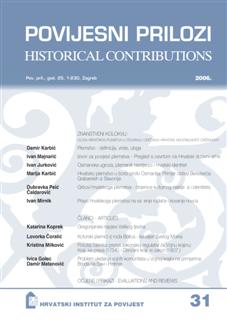Plemstvo – definicija, vrste, uloga
Aristocracy – definition, sorts, role
Author(s): Damir KarbićSubject(s): History
Published by: Hrvatski institut za povijest
Keywords: aristocracy; city aristocracy (patricians); Middle Ages; Early modern Age; social history; historiography
Summary/Abstract: In European history generally speaking, and especially in the Croatian history, aristocracy played one of the most prominent roles from the medieval times until the nineteenth century. Therefore, even though they number in the general population was rather small, their history is well documented ant thus they represent one of the most commonly investigated social groups in the professional and amateur historiography. Author emphasizes that the forming process of this social phenomenon was quite long (about 1000 years – throughout the entire Middle Ages, from the late Antiquity up to the end of the fourteenth century), and that therefore one cannot expect that aristocracy remained unchanged during this long period of time. This development depended not only on the time passing, but also varied regarding the geographical circumstances, so today we cannot claim that this process was unified in the entire Europe. However, historians can define some common factors of these processes that leaded towards formation of aristocracy. During the period of formation, but also later in some ways, European aristocracy did not represent a uniform social group. Namely, in some parts of Europe aristocracy maintained their own hierarchy, while in some other parts all the nobility was legally equal. On the other hand, historians revealed that throughout history there were some social groups that managed to enter in the aristocracy circle. Such groups were iobagiones castri, royal serfs (servinentes regis), ministerials, valvasors etc. Similarly, aristocracy distinguished regarding their organizational forms (noble kindred, dynastic kindred, noble communities etc.). The main purpose of this article is to show all this diversity, especially regarding the terminology used for the groups that existed in Croatia during the medieval period.
Journal: Povijesni prilozi
- Issue Year: 2006
- Issue No: 31
- Page Range: 11-21
- Page Count: 11
- Language: Croatian

